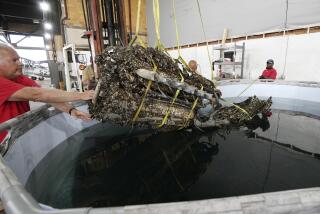‘Vanished’ a gripping tale of search for missing men of WWII
In recent years it’s become a truism that the American military promises “no man left behind” when it goes to war. But in World War II, that promise was often not achievable and may not even have been a priority. More than 73,000 Americans remain missing in action and presumed dead from World War II. Of those, 47,000 disappeared in the Pacific during the “island hopping campaign” that can be said to have begun at Guadalcanal in 1942 and ended in Okinawa in 1945.
Tracking down the remains of the MIAs and piecing together their final moments is the daunting, emotionally fraught quest — undertaken by civilians and the military — at the heart of “Vanished: The Sixty-Year Search for the Missing Men of World War II,” a deeply reported, compellingly written book by Wil S. Hylton, a contributing writer for the New York Times Magazine.
Hylton focuses on the airmen lost in combat, particularly from the 307th Bombardment Group, the “Long Rangers” who flew the B-24 Liberator great distances to bomb Japanese island redoubts and support the Marines and soldiers in their amphibious assaults. “Just as the Marines who rushed onto Pacific beaches would always fall in the shadow of their counterparts at Normandy,” he writes, “the airmen of the South Pacific would never know the fame that fliers in Europe enjoyed.”
Much of “Vanished” concentrates on Pat Scannon, a doctor, chemistry PhD and executive at a Northern California biotech firm. Although he was never an airman, Scannon begins a search for downed planes and missing airmen in “a patch of islands called Palau,” a search that takes years, repeat visits and more than a few disappointments.
The Liberators flew in tight, large-scale formations. The Japanese guns were waiting. The B-24 could carry a heavy payload but was hard to fly and quickly flammable when hit by enemy fire. Some airmen labeled it the Pregnant Cow, others the Flying Coffin. “Each evening the planes came back from Palau shredded by artillery, some of them so badly damaged that it was hard to believe they’d flown…” Hylton writes. “Others didn’t return at all.”
Major figures traipse through “Vanished”: FDR, Tojo, Bob Hope, Nimitz, MacArthur, Charles Lindbergh and a Navy ensign named George H.W. Bush, among them. But it is the missing airmen and their families who give the book its impact.
Many of the airmen “had never left home before or had any idea where they were going. Their uniforms would be their first suits; their barracks, their first homes with lights and plumbing.”
Even decades later, family members are agonized by their loss and lack of certainty. The pain is passed down by generations, often stoked by wild, improbable rumors that a loved one survived and is hiding somewhere, on an island perhaps or even in America under an assumed name.
Scannon tells Hylton he was surprised that so many families still cared, especially the younger members: “The first thing you find out is that the later generations care even more — it’s like there’s an empty chair at the dinner table all their lives.”
Hylton interviews family members and some of the surviving, aging airmen. Some of the most emotional parts of “Vanished” are the letters to and from the airmen as they waited to fly yet another mission, possibly to die in a sky lighted with anti-aircraft fire.
Jimmie Doyle writes to his wife, Myrle, in West Texas: “Sweet, my mind is nearly a blank tonight, for I am all took up with thoughts of you and home. Maybe it won’t be too long until the day when I will be home and we will be together again.”
Doyle’s plane went down in 1944. His widow never spoke of his death and she died in 1992, before Scannon’s search hit its stride. She never let others read the letters and took her pain to the grave with her.
Vanished
The Sixty-Year Search for the Missing Men of World War II
Wil S. Hylton
Riverhead Books: 270 pp., $27.95
More to Read
Sign up for our Book Club newsletter
Get the latest news, events and more from the Los Angeles Times Book Club, and help us get L.A. reading and talking.
You may occasionally receive promotional content from the Los Angeles Times.









